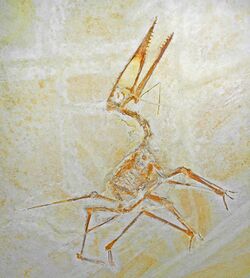Biology:Germanodactylidae
| Germanodactylids | |
|---|---|

| |
| Fossil specimen of Germanodactylus cristatus | |
| Scientific classification | |
| Domain: | Eukaryota |
| Kingdom: | Animalia |
| Phylum: | Chordata |
| Order: | †Pterosauria |
| Suborder: | †Pterodactyloidea |
| Infraorder: | †Archaeopterodactyloidea |
| Family: | †Germanodactylidae Yang, 1964 |
| Type species | |
| †Pterodactylus cristatus Wiman, 1925
| |
| Subgroups | |
| |
Germanodactylidae is a controversial group of pterosaurs within the suborder Pterodactyloidea. It was first named by Yang Zhongjian in 1964, and given a formal phylogenetic definition in 2014 by Brian Andres, James Clark, and Xu Xing. They defined it as the least inclusive clade containing Germanodactylus cristatus and Normannognathus wellnhoferi, which they considered to be close relatives at the time.[1] However, more recent studies by the same researchers have found that these pterosaurs may be only distantly related.
Studies performed in the 2000s suggested this group it contained three genera: Germanodactylus, Normannognathus and Tendaguripterus. Various studies have since placed these pterosaurs within the larger clades Archaeopterodactyloidea,[1][2][3] Eupterodactyloidea, or Dsungaripteroidea,[4] though it has also been recovered within the Ctenochasmatoidea.[5] In several 2010s studies, the supposed "germanodactylid" species were not necessarily found to form a natural group with each other, and even the genus Germanodactylus itself was discovered to be likely paraphyletic, causing one of its component species to be renamed Altmuehlopterus. This would render the name Germanodactylidae synonymous with some other clade, such as Archaeopterodactyloidea or Lophocratia.[3][6]
Korean Late Cretaceous pterosaur tracks have been interpreted as belonging to a Germanodactylus-like taxon.[7]
Classification
Below is a cladogram showing the results of a phylogenetic analysis presented by Longrich, Martill, and Andres, 2018.[3]
| Archaeopterodactyloidea |
| ||||||||||||||||||||||||||||||
References
- ↑ 1.0 1.1 Andres, Brian; Clark, James; Xu, Xing (May 2014). "The Earliest Pterodactyloid and the Origin of the Group". Current Biology 24 (9): 1011–1016. doi:10.1016/j.cub.2014.03.030. PMID 24768054.
- ↑ Chachere, Vickie (April 24, 2014). "International Scientific Team Discovers, Names Oldest Pterodactyloid Species". USF News. http://news.usf.edu/article/templates/?a=6251&z=123.
- ↑ 3.0 3.1 3.2 Longrich, Nicholas R.; Martill, David M.; Andres, Brian (13 March 2018). "Late Maastrichtian pterosaurs from North Africa and mass extinction of Pterosauria at the Cretaceous-Paleogene boundary". PLOS Biology 16 (3): e2001663. doi:10.1371/journal.pbio.2001663. PMID 29534059.
- ↑ Fastnacht, Michael (2005). "The first dsungaripterid pterosaur from the Kimmeridgian of Germany and the biomechanics of pterosaur long bones". Acta Palaeontologica Polonica 50 (2): 273–288. https://www.app.pan.pl/article/item/app50-273.html.
- ↑ Lü, Junchang; Ji, Qiang (2006). "Preliminary results of a phylogenetic analysis of the pterosaurs from western Liaoning and surrounding areas". Journal of the Paleontological Society of Korea 22 (1): 239–261.
- ↑ Vidovic, Steven U.; Martill, David M. (2018). "The taxonomy and phylogeny of Diopecephalus kochi (Wagner, 1837) and Germanodactylus rhamphastinus (Wagner, 1851)". Geological Society, London, Special Publications 455 (1): 125–147. doi:10.1144/SP455.12. Bibcode: 2018GSLSP.455..125V. https://figshare.com/articles/journal_contribution/5139877.
- ↑ Jung, Jongyun; Huh, Min; Unwin, David M.; Smyth, Robert S. H.; Hwang, Koo-Geun; Kim, Hyun-Joo; Choi, Byung-Do; Xing, Lida (23 June 2022). "Evidence for a mixed-age group in a pterosaur footprint assemblage from the early Upper Cretaceous of Korea". Scientific Reports 12 (1): 10707. doi:10.1038/s41598-022-14966-5. PMID 35739247. Bibcode: 2022NatSR..1210707J.
Wikidata ☰ Q517744 entry
 |

